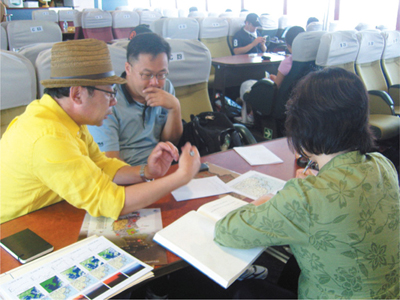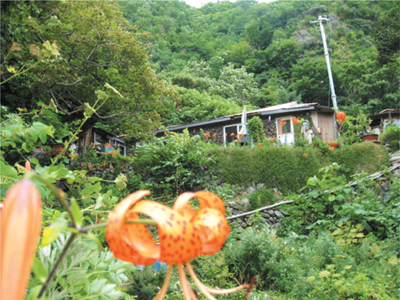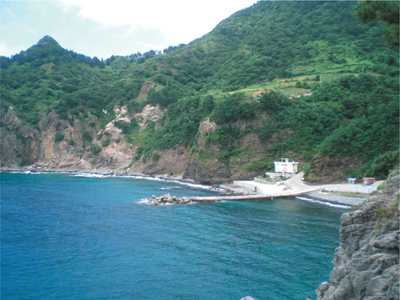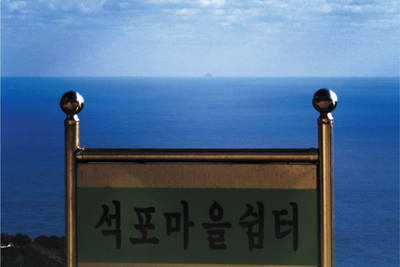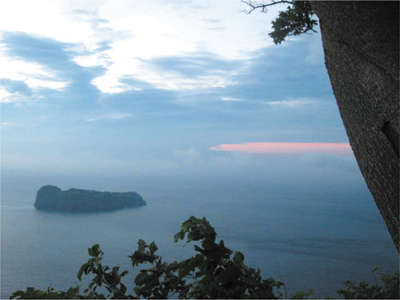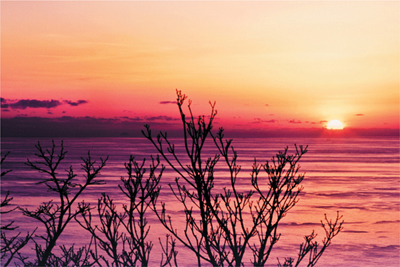- Dokdo in the East Sea
- Controversies surrounding Dokdo
- Dokdo! It can be seen from Ulleungdo
Dokdo in the East Sea
Table of Contents Open Contents
- Dokdo! It can be seen from Ulleungdo
- Overview: Background and Significance of the Dokdo Visibility Study
- Historical Meaning of “Dokdo’s Visibility from Ulleungdo”
-
Dokdo’s Visibility from Ulleungdo: Implications in International Law
- Ⅰ. Reasons Japanese Scholars Denied Dokdo’s Visibility from Ulleungdo
- Ⅱ. “Visibility of Dokdo from Ulleungdo” and Discovery in International Law
- Ⅲ. Dokdo’s Visibility from Ulleungdo and the Concept of Geographical Contiguity
- Ⅳ. Historical and Geographical Integrity and Territorial Sovereignty
- V. The Legal and Historical Unity of Ulleungdo and Dokdo
- The Meteorological Neaning of Dokdo’s Visibility from Ulleungdo
- Postscript after constant monitoring
First Day (July 28)
· Seoul: I left Seoul at dawn to travel to Ulleungdo. I had to wake up before 3 a.m. and leave my family behind. I did not realize the distance between Seoul and Ulleungdo was this far. It suddenly dawned on me how people perceive college rankings. The closer a college is to Seoul, the better. These days, any college in Seoul is considered prestigious. All high school seniors want to go to college in Seoul. It seems everyone in Korea looks up to Seoul. Even resorts outside Seoul must take into account guests coming from Seoul. What about Ulleungdo, that is so far away from Seoul? To get there on the same day, I had to get up in the early hours of the morning. Then what about Dokdo? To make Dokdo an integral part of our lives, I have this wish that we improve access to Ulleungdo from Seoul without having to get up during the early hours to get there. Only then can we see Dokdo become a real part of our life, instead of being some disputed land that only occasionally appears on the news.
· On the boat to Ulleungdo: I met the lady warriors of the Korea Meteorological Administration for the first time. With only slight exaggeration, I found the passion of the researchers at the meteorological administration amazing. The job of analyzing visibility days for the report involved scholarly knowledge and techniques as well as fieldwork experience. In addition, it required a sense of policy implications. For this reason, we had a difficult time enlisting science professionals to join the project. This is one of the reasons for my reluctance when I was offered the job to comment on the historical implications of the project based on the findings of the report. Report writing of this nature was a difficult job indeed as it involved linking the current issue of Ulleungdo with academic controversy, rather than writing a report based on new historical facts. This difficulty could be foreseen even before setting out to work. Still, I could not say no to the offer by Hong Seong-geun, who came originally from Ulleungdo and is a descendant of a Dokdo Volunteer Force commander. I did not say a definite yes, and breathed a sigh of relief when I was told that the person to be responsible for meteorological analysis was unable to be part of the team. But Hong called me and said, “We will go ahead nonetheless. Please continue preparing for the project.” Where did his courage come from anyway? Later he called me again, saying that he had met a group of great people whom we could enlist in our team and asked me to tag along on a field trip to Ulleungdo and Dokdo. I had so many things to do and maybe that is why I was not so comfortable with the idea of going to Ulleungdo. The lady warriors were not even seasick, and their steps were so light and cheerful. So that is how we ended up holding an editorial meeting on board.
· Dodong Port: Dodong Port is the gate to Ulleungdo for ferries moving to and from the ports of Mukho and Pohang on the mainland. The port of Dodong is the center of Ulleungdo because it is the place crowded with 200,000 tourists arriving each year, with the beautiful turquoise sea and many lodgings and restaurants. Once you disembark from the ferry and step in to the port, you can smell fresh air filled with the raucous welcoming greetings of the seagulls. On the right side of the port, you see a 2,500-year-old juniper tree looking down upon you. This juniper tree is the first attraction you see on the island, giving a deep impression to travelers. But I must confess that the waterfront was like a noisy marketplace rather than the lovely wharf that I had in mind, as it was the vacation season. It felt like I was surrounded by people in a small space called Dodong as soon as I disembarked. I needed more time to think about Dodong Port from a distance. Above all, we need to think about Ulleungdo together with Dokdo as a single entity. In addition, we must look at the port of Dodong as a distillation of all activities going on around the island.
· Hakpo: The name “Hakpo” is taken from an image of a crane sitting on a rock in the sea. The beginning of the trip to see Dokdo from Ulleungdo is the story of Inspector Lee Gyu-won 120 years ago. Lee Gyu-won, the author of “Ulleungdo Inspection Journal,” was born in the third month of 1823 (twenty-third year of King Sunjo) at Amjeong-ri, Geumhwa County, Gangwon-do. At the age of 19, he passed the government military examination; he was promoted years later to Royal Guard and Military Training Center Deputy. For 16 years from 1867 to 1882 (from the fifth year to the sixteenth year of King Gojong), he served in positions as magistrate of Jeongpyeong, Dancheon, and Tongjin. In 1882, he was appointed by King Gojong as an inspector to Ulleungdo to discern the current situation on the island. At the time, traveling to Ulleungdo from Seoul must have involved so much inconvenience that it is unimaginable for us today. First, he arrived in Pyeonghae County from Seoul and stayed there for six days to prepare boats and firewood, water, and food. He then went to Gusanpo about 10 ri (four kilometers) from Pyeonghae to wait for a favorable wind. Two days later, his party of 102 finally met a favorable wind. The 82 military officers and sailors, as well as 20 hunters and Magistrate Sim Eu-wan, the military officer Seo Sang-hak, the former chief gatekeeper Goh Jong-pal, and the chief painter Yu Yeon-ho, took three boats and set sail at around 8 a.m. In the middle of the sea, a storm struck with waves reaching high up the boats. The passengers looked around but there was no land in sight. The boats struggled mightily with the waves and managed to land on the western shore of Ulleungdo after great confusion in not knowing the direction overnight in the choppy waters. The landing site was called So-Hwangtogumi (today, Hakpo). What would they have felt after the ordeal in small wooden boats? According to the records, they were tired from the trip. But I am certain they must have been much more than exhausted. Anyway the inspector and his hangers-on finally arrived in Ulleungdo’s Hakpo and engraved this fact on a flat rock as soon as they landed. Even 120 years after their travail, the name Lee Gyu-won is clearly marked on the rock.
Regarding the name “Goh Jong-pal,” which could also mean the eighth year of King Gojong, we argued whether this is a person’s name or a year during the king’s reign. We ended up making a bet about this. The lady warriors of the meteorological administration bet on the year while Hong and I bet on the person’s name. We won and were promised free ice cream from the losing party. But it took us several days to receive and enjoy the ice cream. Lee Gyu-won and his party held the three boats tight at the Hakpo landing 120 years ago. But the anchor cable almost broke during a storm and the sailors were busy tying up the boats with ropes borrowed from a merchant ship. In the end, the boats held up and the sailors visited a nearby shrine to pray for their safe trip back home. Given their desperate predicament, was playing for ice cream 120 years later a little too leisurely?
Even after 120 years, the land has not changed greatly and the lily that the party of Lee Gyu-won must have seen after landing soaking wet welcomed us.
·Taeha: After climbing up the mountain, the party arrived at Dae-Hwangtogumi (today’s Taeha-dong). On their way they saw plentiful graves called portal tombs with a flat stone slate in the middle with smaller stones on four corners supporting it. They followed a stream to a port and found a group of sailors of a merchant ship whose leader was Choi Seong-seo and who lived in tents with 13 workers. Seven of the workers from Gyeongju were making tents while looking for medicinal herbs. Two people from Yeonil were also putting up tents while cutting bamboo trees. They reported that their party had walked 30 ri (12 kilometers) that day through mountain forests. The peaks were so high in the sky, with trees covering the sunlight, and grass-covered trails almost invisible. After dark, the party had to stay in a grass hut. What were they thInking as they walked the mountain trails? Maybe they could see Dokdo while slogging through the trails? Or could not they see anything because the trees covered the sunlight and the tall grass made the trails invisible? I imagined Lee Gyu-won, who may have thought about Dokdo while sleeping in the hut. ThInking of how the inspector felt about his travel, we walked to the cliff in the Hakpo landing and stared in the direction of Dae-Hwangtogumi, where the hut he may have stayed in is located.
Why Dae-Hwangtogumi, then? According to tradition, a Gangneung County magistrate drifted in a boat while enjoying a party with a female entertainer to this island. They almost starved to death and had to eat red clay on the beach. They found the dirt had nine different tastes and named the area after this. (Hwangtogumi means literally “nine tastes of red clay.”) But this is just a story handed down by the island’s residents. In a Gyeongsang-do dialect, “gumi” means a place with a large puddle. Any place name that ends with Hwangtogumi or Sataegumi indicates an area with a punch bowl-like puddle in it.
Out of curiosity, I took a handful of dirt and tried to taste it. As expected, it did not taste like anything except salt. Inside the huge volcanic rock, there was a sliver of red clay, which was strange looking to me. The red clay layer was concentrated on the right wall of the cave. It was interesting to see that the oddly-shaped rock on the gray cliff combined with the red-clay layer have endured for eons. Government officials dispatched from the court during the Joseon period on regular inspections of the island would offer to the court juniper and red clay from the cave as evidence of the visit. The red-clay cave located right in front of the entrance to Taeha Village stands out in this island full of rocks. This is indeed what is special about Ulleungdo.
· Seongha Shrine, Taeha: Located in Dae-Hwangtogumi (Taeha-dong), this is one of the largest shrines in Ulleungdo. The shrine hosts the child brother and sister as the patron saints of the island. At this place, shamans perform ancestral rites every February 28 in the lunar calendar to pray for a good harvest and a big catch. Whenever the residents build a new boat, they perform the rites for safety and prosperity. At the shrine, one can see the statues of the children in their teens made of beeswax. This is unusual in that most shrines host old white-haired men as patron saints. Seongha Shrine is more famous for a sad story about the two teenagers than as a site for folk religion.
During the reign of King Taejong in the early fifteenth century, the Joseon court sought to depopulate Ulleungdo by using Kim In-woo, a rich resident of Samcheok, as a proxy. In compliance with the court’s instructions, Kim arrived at the Dae-Hwangtogumi (Taeha-dong) landing with two navy ships. After gathering all the residents of the island, all he needed the next day was to depart for the mainland. That night Kim had a dream in which a sea god appeared and told him to leave a couple of young children on the island. The next morning when he awoke, he found the dream strange but went ahead with the plan and ignoring the warning in his dream. Soon afterward, the sea near Hwangtogumi turned into a mad monster creating gigantic waves. Kim had to give up the idea of leaving that day. The storm continued for days and he was reminded of the warning by the sea god in his dream. He picked a pretty-looking boy and girl from among the residents and gave them a fake order to fetch his brush and ink. Once the two youngsters disappeared from sight, Kim told his sailors to set sail hurriedly. As they departed from the landing, the storm calmed abruptly. That is how the navy ships could return to the mainland. Meanwhile, the children looked for the writing devices, but they were nowhere to be found. When they came back to the shore, the ships had departed with their parents. They cried out loud, but no avail. From cold and hunger, they panicked. All they could do was hold together to keep warm. Under another instruction from the court, Kim In-woo returned to the island and found the remains of the boy and girl. They had become skeletons holding tightly together. Regretting his coldhearted decision, he had a shrine built where the children perished to appease their souls. That is today’s Seongha Shrine.
This story reflects the hard life of the people in Ulleungdo. Because of the central government’s decision to vacate the island, they had to leave everything behind. But their hearts could not leave with them. This is just one aspect of the sad history of Ulleungdo, along with that of Dokdo.
·Seokpo: It was here. This is one place where one can see Dokdo on clear days. This is also where one can see the great Dokdo Glory. A memorial museum dedicated to An Yong-bok, a pioneer in teaching the importance of Dokdo, is here.

〈FIG 7〉 The House of Baek Tae-cheol Built on the Site of the An Yong-bok Memorial, which has been Demolished.

The presence of An Yong-bok 300 years ago shows vividly the plain fact that the past is never forgotten and lives within us today. It is indeed a bridge linking us with the past. In a situation in which Japan reveals its intentions to be expansionist by making territorial claims on Dokdo while making itself look peace-loving and cosmopolitan to the outside world, we must remember what he did for us 300 years ago.
Day 2 (July 29)
·Seokpo: That Dokdo is visible on clear days made us edgy. When we saw the constant monitoring report the first time, were the photographs of Dokdo seen with the naked eye from Seokpo so beautiful? Was not one of the reasons for us to visit the monitoring spot in person was to see our land Dokdo with our own naked eyes? But the lady warriors from the meteorological administration said after contacting the weather observatory that it would be cloudy early the next morning.
But I saw another Dokdo in the previous night. And met another General An Yong-bok, too. I had a conversation with a middle-aged man who was singing “Arirang” on a spot where the villages with the best view to Dokdo are disappearing after the construction of the An Yong-bok memorial museum.
His name was Lee Deok-jun. His monotonous life of looking out at Dokdo all the time without anyone recognizing it seems like the fate of Dokdo in a way. Dokdo is there no matter what happens, even though we pay attention to it only when a dispute arises. To defend Dokdo in everyday life, he created a window on the side of his house that faces the island. After making the window on the side with the best view in the house, he leaves it open all the time, even in rain or snow. Just like a mother waiting for her prodigal son to come home.
There was a Protestant pastor named Son Yang-won who used to run to the front yard whenever wind blew, thinking that it was Jesus who comes to his house. Maybe unconditional love is just like this? The love of Dokdo may be like this, too, without making much noise and doing what you have to do quietly in your everyday life. Love is not a slogan. It is not academic rhetoric. It is something you do every day in your humdrum life. Publishing a book based on findings from the Dokdo visibility study may be an act of love for our island. This does not have to seem scholarly or professional. All you need do is look at the island while working on your farm. (Somebody said love is feeling good from just looking at a loved one. Then is the visible distance the distance of love? The distance of Dokdo from Ulleungdo, that is the distance of love.) All we want is to feel the love and show this love to other people, too.
On cloudy days, we could not just sit doing nothing. Before going to bed, we said to each other let us meet at breakfast after a good night’s sleep as there would be no Dokdo sighting tomorrow. Despite the long hours of trip on the first day, we all awoke early in the morning without even an alarm clock and stood on the observatory with red eyes. Perhaps we were of one mind. Despite the bad weather, our mind’s eye was already looking out to the sea in the southeast.
A lady warrior even predicted while watching the Dokdo sunrise early in the morning that we could see the sunset, too. This is the moment the so-called Dokdo Glory was born.
· From Seokpo to Naesujeon: Ulleungdo was not an easy friend to make. First, it took as long as three hours from Mukho Port in Donghae. But the first impression of the island was not so friendly. Ulleungdo is like a crustacean that covers itself with a hard shell. The dark-colored, fortress-like basalt cliffs that drop drop straight to the sea looked quite imposing. This fortress blocks the eyesight of the people wishing to see inside the island, and it is hostile toward invasion. The Joseon government inspector Lee Gyu-won wrote of this in greater detail 120 years ago. “The island is full of high peaks that soar beyond the clouds, and the cliffs tightly hug each other. Even though there are beaches here and there, we could not find a place to land.”
Ulleungdo’s defense is formidable. You can see that while driving on the ring road. This road, on which the speed limit is but 40 kilometers per hour, offers quite an unfamiliar sight to mainlanders. Several tunnels are only two-lane roads. That is because it was too difficult and costly to make wider tunnels. The meandering roads along the coastal cliffs seem so dangerous. The columnar joint overhead looks as if it might fall right now.
The history of building the ring road and punching holes through the mountains was a true struggle The history of building the ring road and punching holes through the mountains was a true struggle against nature. Begun in 1963, the project to connect the whole ring road was completed in 2001, except for the interval between Naesujeon and Seommok. Given that it took 39 years to build a road 39.8 kilometers, it took one year to open one kilometer of road. A project to build the 4.3-kilometer section between Naesujeon (Jeodong-ri) and Seommok (Cheonbu-ri, Buk-myeon) was recently approved by the Ministry of Strategy and Finance after a feasibility study. Albeit good news, there is something to be desired. The trail between Naesujeon and Seommok is famous for its ruggedness, and is a favorite for adventurous hikers. This is also the path to Buk-myeon from Nam-myeon, making hikers stop to admire the beautiful scenery in the surrounding forests. The trail along the mountainside moves back and forth between an ocean view and the forest. It is not common in Ulleungdo, with its many volcanic rocks, to have a place where one can see the forest and the sea side by side. Walking on the trail looking at Gwaneumdo, Jukdo, and Dokdo close by, one can not help but to look to the left as if to see the Dokdo Glory sunrise in the morning. Ulleung relaxes herself a bit and allows us to see forests and the sea in one place like this. This is a blessing granted to us by Ulleung.
Jukdo and Gwaneumdo are cut from the same fabric as Ulleungdo. Whenever Ulleungdo residents stretch their backs while doing farm work, they can see Dokdo as if comforting them. I walked and walked. Just like that. In Ulleungdo. Watching Dokdo with my mind’s eye. Thinking that this is Ulleungdo, I kept walking without realizing I skipped breakfast. Thinking how to make people feel the distance between Ulleungdo and Dokdo in their mundane, everyday lives, beyond scholarly discussion of the issue.
I have many more things I wish to write. I met many people while working on the project. I know I have a longer way to go than I have come so far. I also want to tell you a story about making a conversation with Dokdo about love on board to the island. But I think it is better to be incomplete at this point. Leaving the job of completing it to all of you. I can not say for certain whom you will meet there and what kind of story Dokdo will tell you secretly. Anyway, it is your turn now to take the trip!
-
- Ulleungdo
-
Yoo Chi-hwan
-
Why don’t I sail to a small spot in the deep sea in the east called Ulleungdo?
The Changbai Mountain Range comes down to the south leaving a drop in the ocean,
Your loneliness becomes part of the sad land of ours,
You are floating precariously on the choppy waters.
Your beautiful hair is always washed clean by the blue wind of the East Sea,
Day or night your mind comes ashore to the land,
as if it follows relentless winds and waves.
Whenever you hear a dizzying array of news about the mainland,
you feel frustrated that you can’t reach.
Why don’t I sail to a small spot in the deep sea in the east called Ulleungdo?






